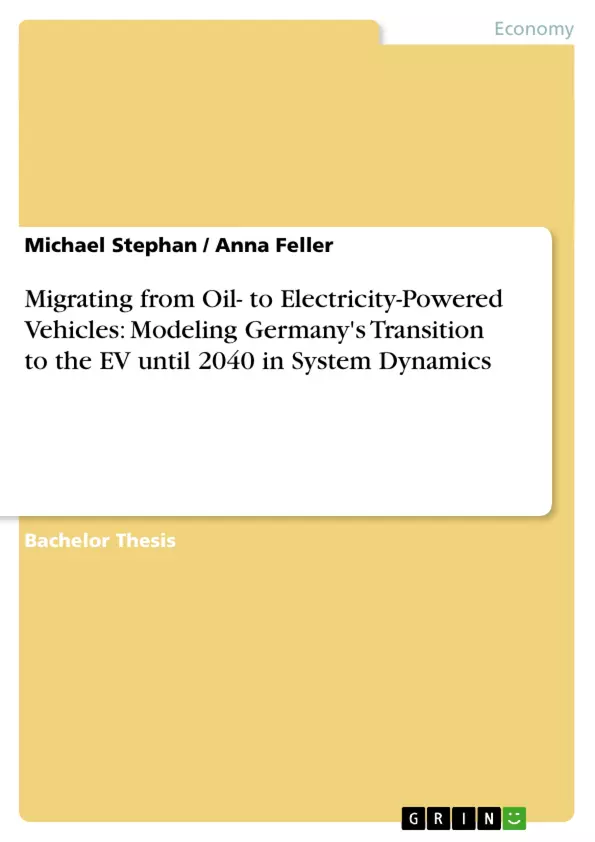Replacing traditional internal combustion engine cars by electric vehicles (EVs) offers significant advantages, such as lower CO2 emissions, lower noise pollution and lower oil consumption. Nonetheless, a potential migration of Germany's personal transportation ector towards the EV faces significant challenges like a low initial driving range and high production costs of the EV, as well as high investment costs into a supporting infrastructure. It is argued that some of these challenges form "chicken-and-egg"-problems that are particularly difficult to overcome.
We analyze these challenges using a comprehensive System Dynamics model calibrated to Germany for the period from 2010 to 2040 with endogenous infrastructure entry and exit, detailed reigonal driving behavior, technological improvement and economies of scale. We conclude that the EV will eventually overcome these initial hurdles after 2002, even though market penetration will remain limited for a long time. The impact of different recharging technologies and a potential up-front deployment of recharging infrastructure are investigated. Furthermore, we evaluate the efficiency and effectiveness of policy measures in support of the EV and aggregate potential annual CO2 emission reductions due to the introduction of the EV for different scenarios.
The thesis includes:
- Concrete, numeric market potential forecasts for Germany under different scenarios and assumptions (including a rapid "Better Place"-style deployment of infrastructure)
- Overview over current EV technology
- A description of a sophisticated System Dynamics model, including algorithms to simulate driving behavior on a regional level (>450 regions for Germany)
- Sensitivity analysis for different technology development patterns and various subsidies (including city tolls for non-zero emission vehicles or infrastructure subsidies)
Model, as well as data is available from the authors upon request.
Inhaltsverzeichnis (Table of Contents)
- Executive Summary
- 1. Introduction
- 1.1. Types and advantages of electrified vehicles
- 1.2. Historic overview
- 1.3. Barriers to entry
- 1.4. Modeling alternative fuel vehicle introduction dynamics in System Dynamics
- 2. Model description
- 2.1. The consumer model
- 2.2. The industry model
- 2.3. The infrastructure model
- 3. Model analysis
- 3.1. Scenario analysis
- 3.2. Sensitivity analysis
- 4. Policy measures in support of electric vehicles
- 4.1. Tax credits for EV purchases
- 4.2. Subsidies for recharging stations
- 4.3. Tolls for city access for high pollution vehicles
- 4.4. Qualitative assessment of other measures
- 4.5. Evaluative summary of policy measures
- 5. Impact of EV adoption on CO2-emissions
- 6. Conclusion
Zielsetzung und Themenschwerpunkte (Objectives and Key Themes)
This thesis aims to analyze the challenges and opportunities associated with transitioning Germany's personal transportation sector from oil-powered to electric vehicles (EVs). It utilizes a comprehensive System Dynamics model calibrated to Germany from 2010 to 2040 to evaluate the dynamics of EV adoption, including infrastructure development, consumer behavior, and policy interventions. Key themes explored in the thesis include: * **The impact of infrastructure development on EV adoption:** Analyzing how the availability and accessibility of charging stations influence EV adoption rates. * **The role of consumer behavior in EV market penetration:** Investigating factors such as purchase decisions, driving range concerns, and price sensitivity. * **The effectiveness of policy measures in promoting EV adoption:** Evaluating various policies aimed at stimulating EV demand and infrastructure development. * **The potential environmental benefits of EV adoption:** Quantifying the reduction in CO2 emissions resulting from the widespread use of EVs. * **The role of technological innovation in driving EV adoption:** Analyzing how advancements in battery technology and other key components influence EV competitiveness.Zusammenfassung der Kapitel (Chapter Summaries)
- Chapter 1: Introduction: This chapter provides an overview of the advantages and challenges associated with transitioning to electric vehicles. It discusses different types of electrified vehicles, their historical development, and the key barriers to their widespread adoption. Additionally, it outlines the use of System Dynamics as a modeling approach for analyzing the introduction of alternative fuel vehicles.
- Chapter 2: Model description: This chapter presents the detailed structure of the System Dynamics model used to simulate Germany's transition to electric vehicles. It focuses on three key components: the consumer model, which captures individual purchase decisions and driving behavior; the industry model, representing the dynamics of EV production and technological advancements; and the infrastructure model, which simulates the evolution of recharging station networks.
- Chapter 3: Model analysis: This chapter analyzes the results of the System Dynamics model, including scenario and sensitivity analyses. It explores different assumptions regarding consumer behavior, infrastructure development, and policy interventions to understand their impact on EV adoption rates and the overall transition process.
- Chapter 4: Policy measures in support of electric vehicles: This chapter evaluates the effectiveness of various policy measures in promoting electric vehicle adoption. It analyzes the impact of tax credits for EV purchases, subsidies for recharging stations, and city access tolls for high-pollution vehicles. Additionally, it discusses other potential policy measures and provides a comprehensive overview of their effectiveness.
- Chapter 5: Impact of EV adoption on CO2-emissions: This chapter quantifies the potential reduction in CO2 emissions resulting from the widespread adoption of electric vehicles. It analyzes different scenarios of EV penetration and compares the resulting emissions with those of the traditional internal combustion engine vehicle fleet.
Schlüsselwörter (Keywords)
This thesis explores the transition of Germany's transportation sector from oil-based vehicles to electric vehicles (EVs). Key focus topics include System Dynamics modeling, consumer behavior, infrastructure development, policy measures, CO2 emissions, battery technology, and the "chicken-and-egg" problem faced by the early EV market.- Arbeit zitieren
- Michael Stephan (Autor:in), Anna Feller (Autor:in), 2009, Migrating from Oil- to Electricity-Powered Vehicles: Modeling Germany's Transition to the EV until 2040 in System Dynamics, München, GRIN Verlag, https://www.grin.com/document/136810



